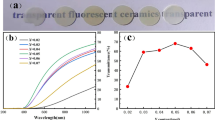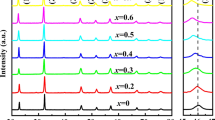Abstract
Lanthanum-modified lead zirconate titanate ceramics Pb0.92La0.08(ZryTi1−y)0.98O3 (y = 64.5 ~ 68.0 mol%) were prepared by a hot-press sintering process in this study. Systematic analysis of the microstructure, dielectric, ferroelectric, and electrically induced light scattering properties were carried out. All samples were crystallized into a single perovskite phase with a dense microstructure. The maximum dielectric constants εrmax decreased with the Zr/Ti ratio increasing (1 kHz), and the P-E hysteresis loops showed that the remnant polarization (Pr) and the coercive electric field (Ec) were significantly reduced accompanied with the gradually enhanced antiferroelectric-ferroelectric phase transition while the Zr/Ti ratio increasing (measured at room temperature). Noticeably, the threshold electric field of electrically induced light scattering performance (examined at λ = 633nm) significantly decreased as the Zr/Ti ratio decreasing. The PLZT (8/65.5/34.5) ceramics exhibited the optimum electrically induced light scattering performance under a very low threshold electric field.








Similar content being viewed by others
Data availability
The datasets generated during and/or analysed during the current study are available from the corresponding author on reasonable request.
References
Z. Peng et al., Doubly Q-switched Nd: YAG ceramic laser. J. Russ. Laser Res. 39(2), 187–191 (2018)
Yun et al., Design and investigation of a novel silicon/ferroelectric hybrid electro-optical microring modulator. Opt. Commun. 385, 130-135 (2017)
G.H. Haertling, C.E. Land, Hot-pressed (Pb,La)(Zr,Ti)O3 ferroelectric ceramics for electrooptic applications. J. Am. Ceram. Soc. 54(1), 1–11 (2015)
G.H. Haertling, C.E. Land, Recent improvements in the optical and electrooptic properties of PLZT ceramics. Ferroelectrics 3(1), 269–280 (2005)
W. Ji, X. He, X. Zeng, W. Cheng, ... D. Wang, Effects of PMN/PT ratio on, optical and electro-optic properties of PLMNT transparent ceramics. Ceram. Int. 41(9), 10387–10393 (2015)
T. Utsunomiya, Optical switch using PLZT ceramics. J. Ferroelectrics 109(1), 235–240 (1990)
C.E. Land, Variable birefringence light scattering, and surface-deformation effects in PLZT ceramics.J. Ferroelectrics. 7(1), 45–51(1973)
G.H. Haertling, Ferroelectric ceramics: History and technology. J. Am. Ceram. Soc. 82(4), 802–803 (1999)
F. Liu et al., Polarization analysis and experimental implementation of PLZT electro-optical switch using fiber Sagnac interferometers. J. Opt. Soc. Am. B-Opt. Phys. 23(4), 709–713 (2006)
P.C. Osbond et al., Coarse-grain light-scattering PLZT. Ferroelectrics 54(1), 203–206 (1984)
S.S. Bains, P.C. Osbond, R.W. Whatmore, F.W. Ainger, P.L.Z.T. scatter mode. Br. Ceram. Proc. 36, 67–78 (1985)
A. Karppinen et al., Electrically controlled optical attenuators and switches with ferroelectric liquid crystals. Ferroelectrics 114(1), 93–97 (1991)
B. Xia, X. He, X. Zheng, Electrically induced light scattering performances of lanthanum-modified lead zirconate titanate transparent ceramics. J. Electroceram. 29(3), 192–197 (2012)
B. Zhu et al., Effects of Bi Doping on the Optical and Electric-Induced Light Scattering Performance of PLZT (8.0/69/31) Transparent Ceramics. J. Materials 12(9),1437(2019)
X. Zeng et al., Effects of lanthanum substitution on dielectric,ferroelectric andelectro-optic propertiesof slim-loop PLZT ceramics. J. Materials ence Forum 913, 459–65(2018)
Y. YLmaz, Y. Babur, A.M. Mamedov, Investigation on the structure of PLZT ceramics due to light scattering. Key Eng. Mater. 264–268, 1297–1300 (2004)
X. Zhang et al., Temperature dependence of electric-induced light scattering performance for PLZT ceramics. J. Am. Ceram. Soc. 97(5), 1389–1392 (2014)
K. Pytel et al., Processing, basic characterization and standard dielectric measurements on PLZT x/65/35 (2 ≤ x ≤ 13) ceramics. Ferroelectrics 499(1), 9–22 (2016)
Z. Hu, B. Ma, S. Liu et al., Relaxor behavior and energy storage performance of ferroelectric PLZT thin films with different Zr/Ti ratios[J]. Ceram. Int. 40(1), 557–562 (2014)
C.-S. Park, S.-M. Lee, H.E. Kim, Effects of excess PbO and Zr/Ti ratio on microstructure and electrical properties of PZT Films. J. Am. Ceram. Soc. 91(9), 2923–2927 (2008)
N. Funsueb, S. Somwan, L. Chumprasert et al., Effect of Zr/Ti ratio on electrical properties of Pb0.91La0.09(ZrxTi1–x)O3 ceramics[J]. Appl. Mech. Mater. 804, 42–46 (2015)
C. Pramila, T.C. Goel, P.K.C. Pillai, Piezoelectric, pyroelectric and dielectric properties of La- and Sm-doped PZT ceramics. J. Mater. Sci. Lett. 12(21), 1657–1658 (1993)
H.D. Sharma, A. Govindan, T.C. Goel, Effect of rare earth ions on the structural parameters of modified PLnZT ceramics (5/65/35). J. Mater. Sci. Lett. 15(16), 1424–1426 (1996)
H.R. Rukmini, R.N.P. Choudhary, D.L. Prabhakara, Effect of sintering temperature on Na-modified PLZT ceramics. J. Mater. Chem. Phys. 64(3), 171–178 (2000)
Z. Xu, X. Zeng, Z. Cao et al., Effects of barium substitution on the optical and electrical properties of PLZT transparent electro-optical ceramics[J]. Ceram. Int. 45(14), 17890–17897 (2019)
Tao Shi, Gen Li, Jing Zhu, Compositional design strategy for high performance ferroelectric oxides with perovskite structure.J.Ceram.Int. 43(3),2910–2917(2017)
Y.H. Xu, Ferroelectric Materials and Their Applications (North-Holland, Amsterdam, 1991), pp. 163–215
S. Somwan, A. Ngamjarurojana, Study of aging behavior of 9/70/30 and 9/65/35 PLZT by optical interferometric technique. Ceram. Int. 41(6), 7536–7542 (2015)
Y. Liu et al., Structure and electric properties of (1– x)(Bi1/2Na1/2) TiO3 – x BaTiO3 systems. J. Wuhan Univ. Technol. Mater. Sci. Ed. 22(2), 315–319 (2007)
E. Breval, W. Chiping, J.P. Dougherty, PLZT phases near lead zirconate: Determination by X-ray diffraction. J. Am. Ceram. Soc. 88, 437–442 (2005)
X. Zong et al., Crystallization and morphology of Pb0.92La0.08(Zr0.68Ti0.32)0.98O3 powders synthesized using the gel-hydrothermal process. Cryst. Res. Technol. 2100053. https://doi.org/10.1002/crat.202100053 (2021)
Y. Xu, Ferroelectric and piezoelectric materials[M]. (Science Press, 222, 1978)
N. Funsueb, S. Ngamjarurojana, A. Limpichaipanit, Effect of sintering condition on electrical properties of PLZT ceramics. Key Eng. Mater. 675–676, 522–526 (2016)
L. Chumprasert et al., Effect of soaking time on phase formation and electrical properties of PLZT based ceramics. Ferroelectrics 457(1), 16–22 (2013)
N. Funsueb et al, Effect of composition and grain size on dielectric, ferroelectric and induced strain behavior of PLZT/ZrO composites-sciencedirect. J. Ceram. Int. 44(6),634–6353(2018) (2018)
A. Kumada, G. Toda, Y. Otomo, An electrooptic image storage device using field induced reversible transitions between AFE and FE phases of PLZT ceramics. Ferroelectrics 7(1), 367–369 (1974)
W. Ji et al., Effect of La content on dielectric, ferroelectric and electro-optic properties of Pb(Mg1/3Nb2/3)O3–PbTiO3 transparent ceramics. Ceram. Int. 41(2), 1950–1956 (2015)
Z. Cheng, L. Zhang, X. Yao, Effect of space charge on micro-macro domain transition of PLZT. IEEE Trans. Electr. Insul. 27, 773–776 (1992)
Q. Yin, Microstructure, property and processing of functional ceramics (Metallurgical Industry Press. Beijing, China, 2005), pp. 57–67
Yu. Huizhu et al., Investigation on the Electric-Induced Light Scattering of PLZT Transparent Ceramics.J. Am. Ceram. Soc. 98(12), 3643–3646(2016)
A.J. Moulson, J.M. Herbert. Electroceramics: Materials, properties, applications [M], p 457–459 (2003)
S. Somwan, N. Funsueb, A. Limpichaipanit et al., Influence of low external magnetic field on electric field induced strain behavior of 9/70/30, 9/65/35 and 9/60/40 PLZT ceramics. J. Ceram. Int. 42(11), 13223–13231 (2016)
MB Rauls, W Dong, JE Huber et al., The effect of temperature on the large field electromechanical response of relaxor ferroelectric 8/65/35 PLZT[J]. Acta Mater. 59(7), 2713–2722 (2011)
Acknowledgements
The authors thank the Innovation Fund (E08ZC7170G) of Shanghai Institute of Ceramics, Chinese Academy of Sciences for supporting the research.
Author information
Authors and Affiliations
Corresponding author
Additional information
Publisher’s Note
Springer Nature remains neutral with regard to jurisdictional claims in published maps and institutional affiliations.
Rights and permissions
About this article
Cite this article
Ling, L., Zeng, X., Qiu, P. et al. Effect of Zr/Ti ratio on electrically induced light scattering property of Pb0.92La0.08 (ZryTi1−y)0.98 O3 ceramics. J Electroceram 47, 1–7 (2021). https://doi.org/10.1007/s10832-021-00253-8
Received:
Accepted:
Published:
Issue Date:
DOI: https://doi.org/10.1007/s10832-021-00253-8




